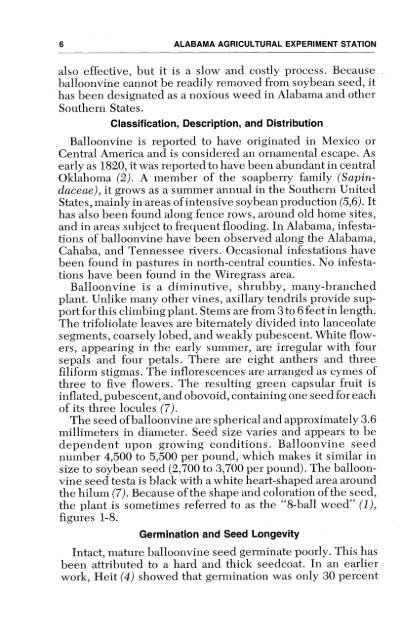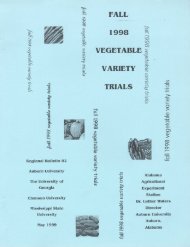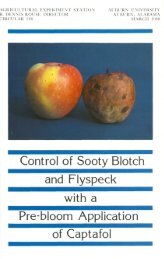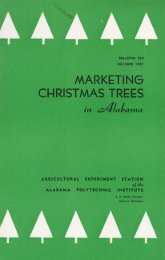Balloonvine Biology and Control in Soybeans - Auburn University ...
Balloonvine Biology and Control in Soybeans - Auburn University ...
Balloonvine Biology and Control in Soybeans - Auburn University ...
Create successful ePaper yourself
Turn your PDF publications into a flip-book with our unique Google optimized e-Paper software.
ALABAMA AGRICULTURAL EXPERIMENT STATION<br />
also effective, but it is a slow <strong>and</strong> costly process. Because<br />
balloonv<strong>in</strong>e cannot be readily removed from soybean seed, it<br />
has been designated as a noxious weed <strong>in</strong> Alabama <strong>and</strong> other<br />
Southern States.<br />
Classification, Description, <strong>and</strong> Distribution<br />
<strong>Balloonv<strong>in</strong>e</strong> is reported to have orig<strong>in</strong>ated <strong>in</strong> Mexico or<br />
Central America <strong>and</strong> is considered an ornamental escape. As<br />
early as 1820, it was reported to have been abundant <strong>in</strong> central<br />
Oklahoma (2). A member of the soapberry family (Sap<strong>in</strong>daceae),<br />
it grows as a summer annual <strong>in</strong> the Southern United<br />
States, ma<strong>in</strong>ly <strong>in</strong> areas of <strong>in</strong>tensive soybean production (5,6). It<br />
has also been found along fence rows, around old home sites,<br />
<strong>and</strong> <strong>in</strong> areas subject to frequent flood<strong>in</strong>g. In Alabama, <strong>in</strong>festations<br />
of balloonv<strong>in</strong>e have been observed along the Alabama,<br />
Cahaba, <strong>and</strong> Tennessee rivers. Occasional <strong>in</strong>festations have<br />
been found <strong>in</strong> pastures <strong>in</strong> north-central counties. No <strong>in</strong>festations<br />
have been found <strong>in</strong> the Wiregrass area.<br />
<strong>Balloonv<strong>in</strong>e</strong> is a dim<strong>in</strong>utive, shrubby, many-branched<br />
plant. Unlike many other v<strong>in</strong>es, axillary tendrils provide support<br />
for this climb<strong>in</strong>g plant. Stems are from 3 to 6 feet <strong>in</strong> length.<br />
The trifoliolate leaves are biternately divided <strong>in</strong>to lanceolate<br />
segments, coarsely lobed, <strong>and</strong> weakly pubescent. White flowers,<br />
appear<strong>in</strong>g <strong>in</strong> the early summer, are irregular with four<br />
sepals <strong>and</strong> four petals. There are eight anthers <strong>and</strong> three<br />
filiform stigmas. The <strong>in</strong>florescences are arranged as cymes of<br />
three to five flowers. The result<strong>in</strong>g green capsular fruit is<br />
<strong>in</strong>flated, pubescent, <strong>and</strong> obovoid, conta<strong>in</strong><strong>in</strong>g one seed for each<br />
of its three locules (7).<br />
The seed of balloonv<strong>in</strong>e are spherical <strong>and</strong> approximately 3.6<br />
millimeters <strong>in</strong> diameter. Seed size varies <strong>and</strong> appears to be<br />
dependent upon grow<strong>in</strong>g conditions. <strong>Balloonv<strong>in</strong>e</strong> seed<br />
number 4,500 to 5,500 per pound, which makes it similar <strong>in</strong><br />
size to soybean seed (2,700 to 3,700 per pound). The balloonv<strong>in</strong>e<br />
seed testa is black with a white heart-shaped area around<br />
the hilum (7). Because of the shape <strong>and</strong> coloration of the seed,<br />
the plant is sometimes referred to as the "8-ball weed" (1),<br />
figures 1-8.<br />
Germ<strong>in</strong>ation <strong>and</strong> Seed Longevity<br />
Intact, mature balloonv<strong>in</strong>e seed germ<strong>in</strong>ate poorly. This has<br />
been attributed to a hard <strong>and</strong> thick seedcoat. In an earlier<br />
work, Heit (4) showed that germ<strong>in</strong>ation was only 30 percent
















